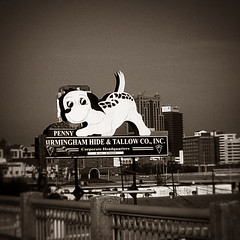 One2Believe: Christian action figures hit the mainstream.
One2Believe: Christian action figures hit the mainstream.
David Socha had a problem with the toy aisle: Too many dolls for girls promoted promiscuity, and too many action-figure collections for boys included villainous demon types — or “spawns of Satan,” as he puts it. “The bigger subject is that evil is glorified,” he says. “Like it’s kind of cool to break the Ten Commandments and do things that even 20 years ago people wouldn’t think about promoting — just being as violent and overt as possible.” Socha, who happens to be in the toy business himself, figured that enough parents felt this way to make up a market. And among the retailers with some faith in that notion was Wal-Mart, which this summer began selling Biblical figures made by Socha’s company in more than 400 of its stores. …
Continue reading at the NYT Magazine site.
Once again I’m away from home with little time to post, but to follow up the earlier bit about the Blackwater Brand, I had to pass along this BoingBoing link about Get Your War On, which asks, “Why not just call themselves Deathfang’s Midnight Posse of Merciless Skull Warriors?” (Thanks also to JKD on this.)
Posted Under:
Pleasing,
Update by Rob Walker on October 6, 2007
Comments Off on Blackwater brand follow-up
Many great images to choose from by our friend Amy Evans. I went with this one, but it’s a good bet I’ll go back for more.
I am startled to learn, via Unbeige, that Herbert Muschamp has died. Here is the obituary. Unbeige’s post suggests a trip to the Times archive to “curate your own Muschamp tribute,” a suggestion I would normally ignore. But I have admired his writing many times (I never met him; by the time I was around the NYT, I’d decided that it’s sometimes better for me to never meet my writing heroes), and there’s one piece in particular that has stuck with me for, wow, 14 years now.
It’s this one, from 1993, the year of the bomb attack on the World Trade Center that failed to bring it down but that was, trust me, pretty unnerving just the same. I was young and newish to New York at the time, but I don’t think I was the only one who felt that way.
We all know that a society’s tallest buildings — the ones that are most easily seen by the most people — reveal what’s that society revolves around: In one era it’s churches, in another palaces, in another, corporate HQs. This essay was headlined “Things Generally Wrong In The Universe,” and in a way it made a case that the tallest building had become the the one that is exploding. That’s the one we all see.
Of course I’m not able to say what he did as well as he did and my clumsy interpretation is probably a disservice, so here’s a passage:
Exploding buildings are this community’s landmarks — its inverted arches of triumph, its sinister Taj Mahals. They provide images of a collective experience that is otherwise elusive. Traditionally, we look to buildings to provide symbols of social cohesion. Exploding buildings now perform an equivalent symbolic role. People may build in different styles, but explosions are universal. Though each may have a different cause, they become linked in our perceptions to some fearful grand design. They focus public attention. They fill up TV screens. The World Trade Center bombing spawned a new style of disaster T-shirt.
Maybe it’s better to just link.
Posted Under:
Obituaries by Rob Walker on October 3, 2007
Comments Off on “Inverted arches of triumph, sinister Taj Majals”
So I happened upon this glowing account of yet another consumer-generated ad stunt, this one for Friendly’s.
For the iScream campaign, consumers were encouraged to “show their love for Friendly’s ice cream or life itself” by posting original photos and videos to the www.iscreamfriendlys.com microsite.
Right, right, the usual thing. Of course it’s rare that there’s enough raw brand fandom around to make these things work, so as usual this consumer revolution is incentivized: The best photos and videos would get prizes. And those were? Apple “sprees” of $10,000, $5,000, and $2,500, plus a bunch of secondary prizes like iPods and Macs. (And a few Canon products.)
I guess $10,000 worth of Friendly’s ice cream wasn’t going to cut it.
Anne Elizabeth Moore points to this Brandweek article:
Japanese car shoppers who test drove a Nissan vehicle were given a free logoed coffee mug for their time as a thank you. At least one consumer probably wished he had said, “No, thank you.”
According to reports, after drinking from the China-made freebie, he felt ill. It was later discovered that the mug contained excessive amounts of lead. More than 140,000 mugs were subsequently recalled. . . .
[Join and contribute to the Murketing Flickr group]
Posted Under:
Flickr Artifacts by Rob Walker on October 2, 2007
Comments Off on Flickr Interlude
The exhibition Sympathy for the Devil: Art and Rock and Roll since 1967, at the Museum of Contemporary Art in Chicago, sounds pretty cool. But what about the collateral merch? Well how about a Rolling Stones Kubrick, eh?
The Rolling Stones lips logo is nearly as iconic as the group itself. Inspired by Kali, a Mother figure in Hinduism with large lips and Mick’s own mouth, it took artist John Pasche just one week to create it in 1970. Here, Medicom features the logo on their 100% (3″) and 400% (11″) Kubricks.
I have a secret wish that there are Kubrick fanatics who will respond to this by wondering who the Rolling Stones are. But of course that’s absurd: everybody knows they’re those older guys who do music for lots of TV commercials.
There’s a lot to get to in the Murketing Flickr pool. I’m already behind. More in the days ahead.
[Join and contribute to the Murketing Flickr group]
 Chase +1: To gain campus recognition (and customers), a bank hooks up Facebook.
Chase +1: To gain campus recognition (and customers), a bank hooks up Facebook.
About a year ago, JP Morgan Chase started a new credit-card program aimed at college students, working with Facebook, the social-networking site. “We felt Facebook would be a good partner for us, since they had such strong credibility in the students’ world,” explains Sangeeta Prasad, who oversees branding for Chase Card Services. “And we felt, you know, financial institutions lacked credibility. Students don’t see credit-card issuers or financial institutions in general as meeting their needs.” Thus the company started offering a new card it called +1, primarily by way of a “sponsored” Facebook group….
Continue reading at the NYT Mag site.
Posted Under:
"Social" studies,
Consumed by Rob Walker on September 29, 2007
Comments Off on In Consumed: A For-Credit Course
“They say that some things just sell themselves. Some things will apparently just have to.
“found in our dumpster
ypsilanti, michigan.”
[Join and contribute to the Murketing Flickr group]
Let’s say, just for the sake of argument, that you’re starting a business that happens to be more or less an extragovernmental army. Your employees will be weaponized, trained to kill, and available for hire. Your accountability will be murky at best. In fact the whole organization would be kind of secretive and vague. It sounds a little scary. A little sinister. A little dystopian sci-fi.
What would you call your organization? Wouldn’t you want to go for something reassuring? Sort of the way that lobbying organizations adopt innocuous, feel-good names? Maybe you’d go with something like Blue Sky, or Sunshine, or Tranquility. Something that would suggest to anyone who heard about your organization in passing: “That sounds pleasant. Nothing to worry about there!”
Would you, under any circumstances, call your organization Blackwater? Maybe it’s just me, but that name kind of suggests, I don’t know, sinister bad guys in a sci fi movie. That seems bad for PR. Especially when your organization becomes involved in a deadly firefight that mushrooms into an international incident. Don’t you think?
On the other hand, I guess it makes for cooler merch.
Another fine Flickr contributor, lorenzodom captions this one: “The errors of great men are more fruitful than the truths of little men. — Friedrich Nietzsche.”
[Join and contribute to the Murketing Flickr group]
As mentioned earlier this morning: I used to post what I called “Flickr Interludes” on this site all the time. I did so because I enjoy looking at Flickr, and I’m consistently impressed by the stuff I see there. I always linked back to the originals, and credited each image as a Flickr photo by [whatever the photographer’s user name is]. The point of the Interludes was to show off cool work that I think is relevant to the subject matter of this site, and obviously giving people full credit is intrinsic to that, so that’s why I always did it. Also, I only used an image here if the “blog this” feature was enabled.But I stopped when I got some mild static once or twice and didn’t understand what it was about.
Someone explained to me that it was indirect fallout from this apparent controversy: Consumerist.com was taking images from Flickr and using them without any particular creidt, and at first responded in an asshole-ish way to complaints. Soon the Consumerist guy wised up and backed off and more or less made amends and promised to give people credit and all that, so the controversy blew over. But it all still made me decide not to do the Flickr thing for a while. Credit or no credit, maybe some people just don’t want their images on this site.
Finally I found the time (okay, it only took five minutes, but still) to create the Murketing Flickr pool. I created the group Wednesday night, and it already has 53 members and 159 images, which is cool. As is clearly explained there, it’s open to all kinds of images of consumer culture, defined as broadly as possible, and I will post highlights on this site from time to time. So if you don’t want to see your Flickr work highlighted here, don’t join. But if you do want to help brighten up Murketing — join in.
More early highlights later today and this weekend and on into the future.
Meanwhile: If you’re a Flickr person and I have highlighted one of your images in the past and you don’t want it used here, just say so, and I’ll take it down. Fair enough?
 One2Believe: Christian action figures hit the mainstream.
One2Believe: Christian action figures hit the mainstream.



 "
"




















 Kim Fellner's book
Kim Fellner's book  A
A